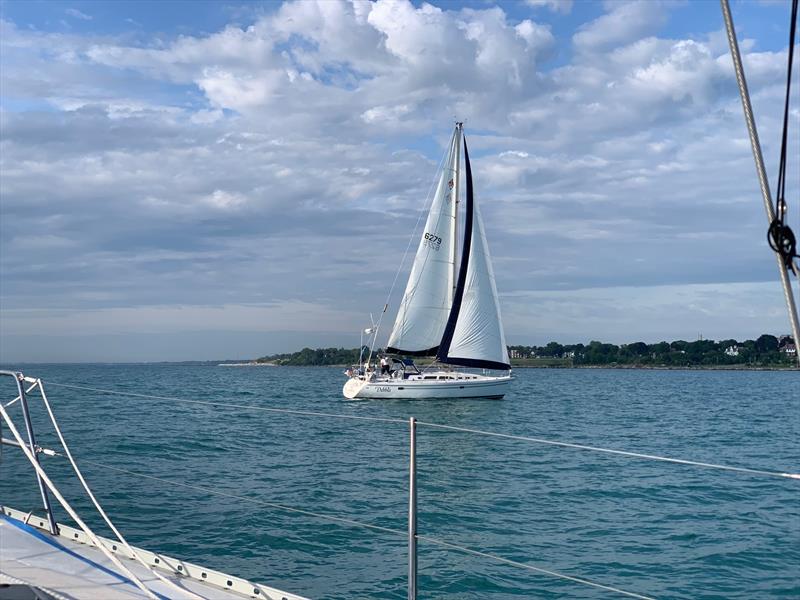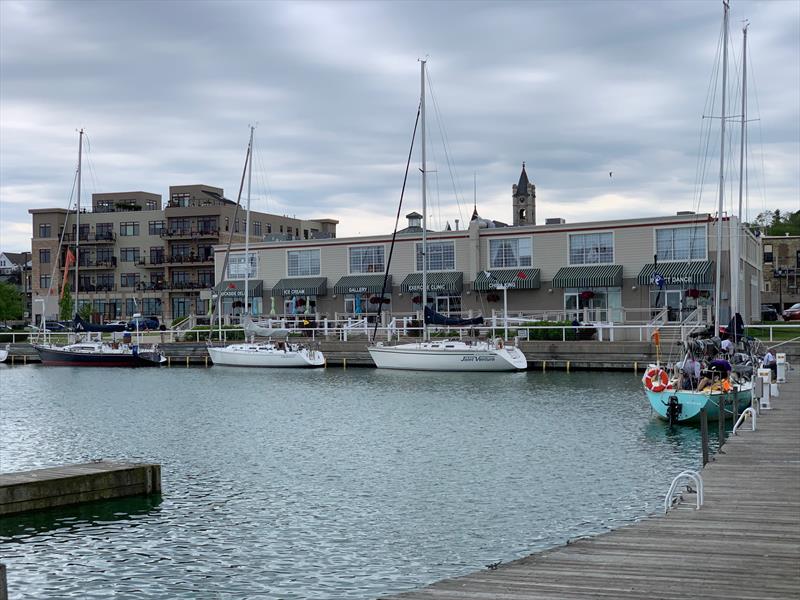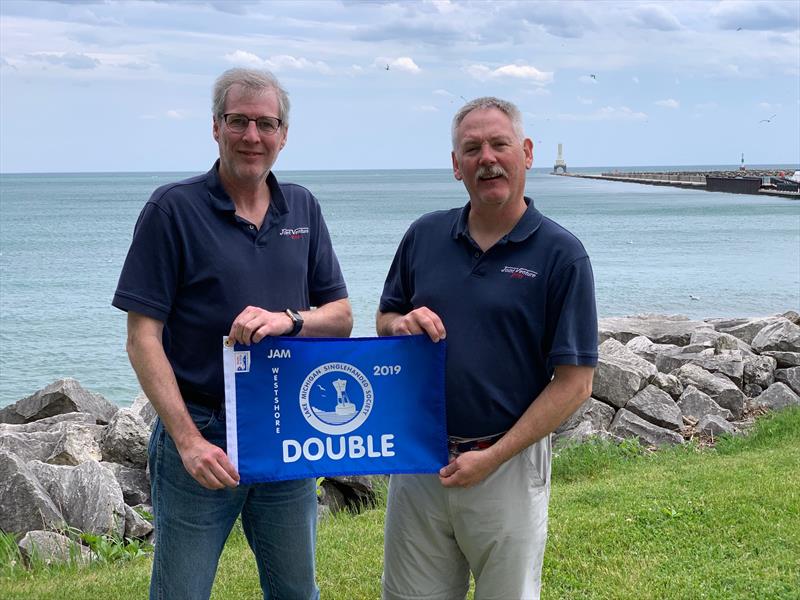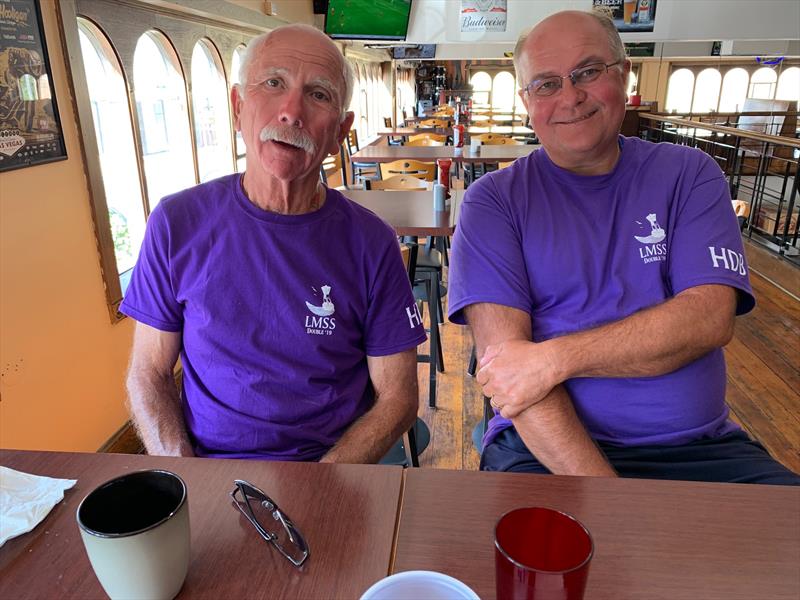Haul out was Saturday, October 10. Lots of winter projects to do.
Chichester
Monday, October 12, 2020
Friday, September 11, 2020
Friday, August 7, 2020
SHMOKIN’ JOE OVERBOARD INCIDENT IN 2020 HOOK RACE
Below is another story about the MOB that took place during the 2020 HOOK Race. You can find the original article at: http://lmsrf.org/images/stories/newsletters/2020/2020_08_LakeMichiganSuRF.pdf
I know, and often compete against the owner of Shmokin Joe, Jeff Schaefer, and know him to be a very good sailor with a lot of experience that puts safety as one of the most important aspects of sailing. I only say this because I suspect that there will always be an armchair sailor that will second guess everything that happened...Dave
by Gail Turluck, John Weiss and Randy Bredin. The 2020 HOOK Race had a successful overboard recovery of Sarah WalkerPederson, Ft. Myers, Florida,from the J/111, Shmokin’ Joe. This story is from input from John Weiss and Randy Bredin an interview with Sarah Walker Pederson, the recovered sailor, and an interview with Jeff Schaefer, owner of Shmokin’ Joe.
More than thirteen hours into the July 18, 2020 HOOK Race, on Sunday morning at about 0215, Shmokin’ Joe reduced its sail plan by taking down their A2 spinnaker and setting the #4 jib, as they were aware from public weather forecasts that a storm was approaching. Shortly thereafter the main sail was taken down. There was lightning for an hour before the squall hit. The crew watched boats to the west when could see them for clues of incoming weather. Sarah was the forward most crew, on the coaming. This was the second squall of the race. They were about 5 miles northeast of the Sturgeon Bay shipping channel. The wind built, they knew the storm was coming in, and three crew were on the coaming but not feet over the rail. Shmokin’ Joe was on port tack making about 7 knots on jib only.
At about 0400, Shmokin’ Joe was knocked down during the second storm endured during the race. The microburst suddenly shifted the wind direction about 70degrees to the northeast for a brief time; it eventually returned to the west. This caused a slam tack from port to starboard tack, suddenly putting the “high side” crew on the low side, in the water. The wind speed was high enough to foam the surrounding water. The crew estimated the wind speed to be over 70 mph. Shmokin’ Joe was on its side, rudder above the water. She was pinned down for about five minutes, according to the owner.
All crew on deck were tethered in when the storm hit. Sarah’s stepson, Matt Pederson, was aboard the Tartan 10 Monitor on the helm in the storm; he said it was raining so hard he couldn’t see the instruments on the boat’s mast. The J/111 broached. As the boat rounded up into wind, Sarah grabbed a winch but couldn’t pull up. As the boat was rounding up, water washed along the deck; this lifted Sarah out of the boat. The snapshackle on Sarah's tether released for unknown reason. Sarah did not panic, but remembered all of her safety training and years on the water. She quickly illuminated her strobe, pulled out her whistle and began making noise while conserving energy in the 56° water. One tethered crewman, on his back with no leverage to pull up on anything, was pulled back onboard promptly. It is undetermined whether he was fully out of the boat, as the boat was on its side and he felt a lifeline beneath him while in the water. A headcount was done quickly while pinned and Sarah was determined to be overboard. Later inspection shows the spring and pin on Sarah’s tether to be intact; it was new in 2017.
MOB called by the owner and all crew engaged in the search. Micki Nielson was below, off watch, standing when the knockdown happened. The VHF radio is on the starboard side. She had to climb up to it. Mickey attempted to push MOB button, it wouldn’t activate and it
wouldn’t lock in. She took out her phone and took a photo of the GPS bearing display with her phone camera so they had a reference for Sarah’s location. This was critical information for the successful recovery. Mickey radioed a Mayday call while Shmokin’ Joe was on her side. Communication through the hatch board wasn't easy, as the wind, rain and rushing water on the hull was loud. The boat also suffered a second broach and knockdown.
Locating Sarah was difficult while the storm moved east. It was raining, dark, and seas,while diminishing, were still present.
Sarah said she bobbed up out of the water, free of the boat, and could still see Shmokin’ Joe on her side. Then there was a heavy, torrential downpour, she couldn’t see and lost sight of boat. She turned on the Forespar strobe. Sarah said, “I was lucky. I didn’t have the cold shock, even though the water dropped to56 degrees. I didn’t feel like it was really cold. I had on full high-top Sperry boots and kicked them off. I had on inshore weight trousers, an inshore weight Henri Lloyd smock with no hood, kept those two on,and had no head covering.”
Rather than a currently popular inflatable Personal Flotation Device, Sarah was wearing an Extrasport foam PFD, a kayaking model with open armholes. Sarah said, “I feel that I survived because I was in a regular foam life jacket, not an inflatable. I had back and front flotation which help maintain my position like a cork, rather than laying on my back, which helped navigate the 5 foot waves. I felt I could ride over the top of the waves better when treading water, I was kept more upright position.”
She said she shifted body position so her shoulder was turned to the waves as bigger waves came that were going to wash over her, to not swallow a lot of water. She initially blew the whistle, but when she couldn’t see the boat anymore, stopped to conserve her strength. She has no time frame for the experience, only that time passed. Later on when trying to use the whistle, she said, “My breathing wasn’t regular. I strove to not hyperventilate, so would blow the whistle intermittently.”
Owner Jeff Schaefer said, “When the boat came out of the knockdown, the #4 jib was doused, lines were checked to be aboard, the engine started and engaged to start to look for Sarah.” They had to motor back to the area where she had gone over the side and used the coordinates from the cell photo to return. It took the crew just over an hour to spot her strobe light.
At one point Sarah saw a spot light scanning. It was the emergency light carried and deployed by Shmokin’ Joe. The rain had let up, she could see Shmokin’ Joe coming at her. The crew had seen the strobe light. As they approached they heard the whistle! Crew member Randy Bredin said, “Best sound I've ever heard. Emotions were noticeably high, but Sarah's voice straightened us out!”
They had a throw bag ready. They threw it, she was able to swim to it and hold on. The crew pulled her alongside and brought her aboard. The crew of Shmokin’ Joe recovered Sarah about 0500. It was starting to get light out and the rain had let up.
The water temperature was 65-70° until the storm, but the Coast Guard reported that the lake water had turned over which led to the water temperature dropping to 56°. The Coast Guard came alongside Shmokin’ Joe almost immediately after Sarah was pulled aboard, helped her into a basket and transferred her to the Coast Guard boat. The Coast Guard took her to the Sturgeon Bay Coast Guard station, right at the end of the shipping channel. EMS was waiting on shore to take her to Door County Medical Center in Sturgeon Bay. She was diagnosed with hypothermia. She said she had really bad leg cramps due to the hypothermia and was in the hospital for about 4 hours. She was treated with warm saline, a warm blanket, got normalized and was released. She suffered no physical injuries other than a few small bruises.
Sarah said, “My biggest fears were that the strobe light would go out and coping with the leg cramps that were making treading water difficult. I later learned the Forespar strobe materials state that with a fresh battery it will light for 24 hours. I told myself in the beginning,‘I know what to do,after 55 years of sailing this doesn’t have to be my end.’”
Sarah said that she swims a lot, does exercises in the water regularly, and thinks that helped a lot. She believes it important to be able to handle and be comfortable with being in the water for an extended time.
Sarah said initial on board reports had wind speeds at 50 mph, but Shmokin’ Joe’s instruments stopped registering. Other boats reported highest speeds of 70 mph and 80 mph, but that’s heresay.
Sarah said the crew collectively used their experience and preparation to find her. She did not see any other boats.
Aboard the J/111 Shmokin’ Joe were owner Jeff Schaefer, with crew Micki Nielson, Rob Walker, Mike Reisinger, Nick Ponsonby, Mark Lewis, Randy Bredin, and Sarah Walker Pederson. The crew was delighted to hug, cry, smile and laugh later that morning in Sturgeon Bay with all the Shmokin’ Joe crew together.
Sarah, a Kenosha native and recent retiree to Florida,said she will get out and do more racing. She plans to get a water-activated strobe light. Even after her experience, she said, “EPIRBS are expensive. I don’t know that I’ll get one. I wear a foam life jacket at night to keep warm and will keep doing so.”
She had an inflatable PFD on during the day because it was 90 degrees and the foam vest would have been hot. However, for night time, she likes comfort of the foam PFD, both for warmth and for comfort on the rail and lifelines. She also said she has a concern with inflatable PFD’s that she doesn’t want to worry about a mechanical failure.
Sarah is a Fifth grade teacher, now entering her second year in the Lee County schools in the Ft. Myers, Florida area, having retired from Kenosha Schools after 25 years. She has taught sailing at the Offshore Sailing School at Sanibel, Florida.
Sarah’s purpose for telling the story is to help others. She stated that safety equipment is important, but it’s equally important for users to know how to use their equipment and be comfortable with it. She also wants to publicly recognize Jeff Schaefer and the crew for their great work in her recovery.
Jeff Schaefer said, “Taking the Safety at Sea course is really important. We had five people aboard who have taken it. Because of this, they knew things to do to help ensure a recovery could be done. I’ve taken both in person and computer based Safety at Sea. I found the on line course to be better. I could take my time, review material, and I learned more. I highly recommend it.”
Friday, July 24, 2020
Overboard During the 2020 HOOK Race
Swept overboard in a storm, Kenosha native survives with help of safety gear and devoted crew
Deneen Smith
The original article (with pictures) can be found at: https://www.kenoshanews.com/news/local/swept-overboard-in-a-storm-kenosha-native-survives-with-help-of-safety-gear-and-devoted/article_c80ba5c7-97e8-596d-8749-a2c4244864c2.html?fbclid=IwAR1v2FbQXvLbFAdejt6A3VB3gawQMykxF5u5FPJeJwdhx92txYOj0GibIw4#tracking-source=home-top-story
Monday, June 15, 2020
Sail-World.com Article on 2020 LMSS Doublehanded Championship
I had to drop out of this year's event due to a death in my family.
Mike Kenny on the 2020 Lake Michigan Doublehanded Championship
by David Schmidt 9 Jun 08:00 PDT June 11, 2020
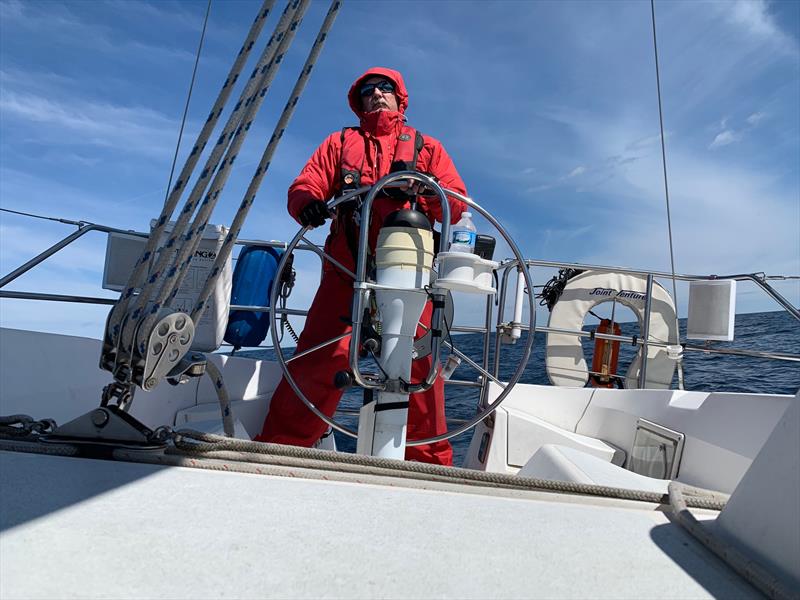 Mike Bush on the helm. A rough day on the water beats any day at the office © Image courtesy of Phil Bush
Mike Bush on the helm. A rough day on the water beats any day at the office © Image courtesy of Phil Bush
In Great Lakes racing circles, this annual event is known as the “Double” or the “Doublehander”, and it gives participating sailors, racing aboard boats that measure 26 to 45 feet, LOA, with an opportunity for adventure and great shorthanded racing.
While there’s plenty of interesting details surrounding the Doublehander, one of the regatta’s unique attributes is its use of two starting lines. Sailors who are racing in the East-Shore Division will start on a line off of Muskegon, Michigan, and they will sail a 65-plus nautical-mile course of their choosing to a shared finishing line, which will be located off of Port Washington, Wisconsin. Sailors competing in the West-Shore Division will start at a line that will be situated off of Winthrop Harbor, Illinois and they will sail a 54-plus nautical-mile route of their choosing to Port Washington.
Granted, doublehanded racing represents an easier format for sailing in the dark shadow of COVID-19, as there’s far more opportunity for sailors to safely socially distance themselves from their teammate than aboard fully crewed racing yachts, but the event organizers’ precautions and commitment to keeping sailors safe amidst this pandemic didn’t stop with simple headcounts.
I checked in with Mike Kenny, chairman of the 2020 Lake Michigan Doublehanded Championship, via email, to learn more about this exciting event.
In a word, uncertainty. Almost every day the landscape is changing and timelines get extended. Also, since our event has starts in Michigan and Illinois, with both finishing in Wisconsin, we must abide by the requirements and recommendations of three different states.
Have you and the other organizers had to change any aspects of this year’s Doublehander due to COVID-19?
Yes, we have made significant changes. This includes eliminating all group gatherings. We are distributing race materials electronically and providing curd-side pickup. We are holding conference-call-based skippers meetings, and [we] will use VHF broadcasts for last-minute updates. We are foregoing our luncheon and awards banquet.
This year’s race is going to come together at the start line.
Where do you expect that most of the 35 registered boat will hail from?
Word is getting out, [and] registered boats are now approaching fifty. We have a good distribution of entries from Illinois, Michigan, Wisconsin, Indiana and Missouri.
What kinds of onshore social-distancing practices will the event employ? Also, how do you plan to enforce these policies?
This is the unfortunate aspect of the changes we have had to make this year. All of our onshore activities have been canceled or modified to eliminate bringing our entrants together.
Even so, we have received nothing but thanks for going forward. Everyone is clamoring to participate in a safe event on the water.
Our shorthanded doubles port-to-port format is very conducive to safe-play. We have two separate starts that are over 100 nautical miles apart, and the course is about 65 nautical miles. Plenty of room for "social distance".
This event has always been very friendly and many teams are family members. But don't be fooled by the pleasantries, this is a competitive bunch.
Will the RC physically be on the water in a boat together, or will they be running things from ashore? If not, how will they practice social distancing?
[The] RC will be on the water for the starts and finish. They will be small teams of folks that are familiar with each other and have been safely intermingling.
Protests are extremely rare for our events. The customary damage must be a hole large enough to kick a cat through from 25 yards and must be submitted on the proper 4”x4” bar napkin.
Regardless, protest time limits are extended. We will accept protests via email and will handle via video conference.
In your mind, what are the best aspects and challenges of this race?
The best aspects are without a doubt our participants. [It’s] a phenomenal group of accomplished sailors. Normally our biggest challenge is scheduling. This year it's clearly the logistics of organizing this event with our different, diverse and incredible host marinas and yacht clubs, [namely] Port Washington Marina, Port Washington Yacht Club, North Point Marina, Winthrop Harbor Yacht Club, Muskegon Yacht Club and Racine Yacht Club.
While socializing is a huge aspect of our sport, I believe most prefer to be actively racing. Keep participants separate by eliminating all gatherings. Host a video post-race if you must party. Offer shorthanded race versions. Use electronic communications. Stay within—and reinforce—Covid-19 guidelines.
[The] utmost priority is to ensure your participants stay safe.
Anything else that you’d like to add, for the record?
If you are in or planning to be in the Illinios, Michigan, Wisconsin area, please join us.
Details and Entry available at lmssonline.com
Original article can be found at: https://www.sail-world.com/news/229257/Mike-Kenny-on-the-2020-Doublehander
Follow www.sail-world.com for the latest in sailing news.
Thursday, March 5, 2020
Monday, March 2, 2020
Lake Michigan will break February record
Lake Michigan will break February record
Posted: / Updated:

The Big Red Lighthouse can be seen across the Holland channel, filled with ice, on Feb. 16, 2020.
The record won’t be official until next week, but the U.S. Army Corps of Engineers’ weekly report released Friday showed the lake remains 4 inches above the February record.
All month, Lake Michigan has been 4 to 6 inches above the record from 1986. Monthly records are set by taking the average water level for the entire month.
The good news for lakeshore homeowners is the lake has actually dropped 2 inches over the past month. However, it remains 15 inches higher than a year ago and is forecast to rise 2 inches by the end of March.
All of the Great Lakes remain near or above monthly records. Lake Erie is 5 inches above the February record. Lake Ontario is 4 inches above the February record. Lake Superior even with the February record. Lake Michigan and Lake Huron are treated as one lake by the Army Corps.
The original article can be found at:
https://www.woodtv.com/weather/rising-waters/lake-michigan-will-break-february-record/?fbclid=IwAR1pdrtbuLfKNEm_uIsEY2ssPkpAO663pP-f82qF1nGJktg0ZZWXPJnfkyM
Thursday, February 13, 2020
How To Train For the Upcoming Racing Season
2. Apply sunscreen to your face in streaks and sit in front of a sun lamp for 2 hours.
3. Sit on a bench with large metal fixtures cutting into your legs, stare straight up into the sun for two hours – for a more robust workout: invite 4 friends to come over and yell at you the whole time.
4. Go out and get very drunk, sleep 4 hours, then stand on a rocking chair for 6 hours.
5. Go to bank and withdraw $1,000 – then light it on fire.
6. Sit in front of a commercial fan and have someone throw large buckets of salt water on you.
7. Repeat number 6 in jeans and a sweatshirt and /or repeat number 6 with head turned sideways to ensure water lodging fully into ear drum.
8. Cut limb off nearby tree, tie ropes to it, stand on rocking chair with tree limb and ropes – hold them over your head for 3 hours… at 5 minute intervals drop on your head – more robust version: have friends yell at you in 6 minute intervals.
9. Set your wrist watch to 5-minute repeating counts … let it go off all day long.
10. Pour cold water in your lap and give yourself a wedgie, now alternate between sitting and running around bent over.
11. Tie ropes between 2 trees – push your body against them as hard as you can for 6 consecutive hours – don’t stop for pain or bruising.
12. Place sandpaper on your stairs, crawl up and down on your knees for several hours.
13. Make 12 sandwiches on white bread with bad meat and cram them into a bread bag – eat one a day for 12 consecutive days… make sure the last one is peanut butter and jelly if preparing for Race Week.
14. Tie ropes to rear bumper of friend’s car, hold on tightly, but allow rope to slip through fingers as car drives away – TIP: works best with nylon fiber ropes, lengths in excess of 50′.
15. Upon completion of previous 14 drills – sit down and drink 14 Mount Gay Rum drinks, any flavor.









